Report on Business Communication: Theories, Barriers, Strategies
VerifiedAdded on 2023/01/05
|10
|2182
|30
Report
AI Summary
This report provides a comprehensive overview of business communication, focusing on its importance in professional settings. It delves into various organizational theories of communication, including the 7 C's of communication, formal, informal, and directional communication methods. The report analyzes common barriers to effective communication, such as emotional, physical, cultural, organizational, personal, and language barriers, and discusses the impact of each. Furthermore, it outlines strategies that companies can employ to overcome these barriers, including employee orientation and the formation of informal groups. The report also offers recommendations for improving communication practices, such as managing emotions, using clear language, and utilizing various communication theories. In conclusion, the report emphasizes the significance of effective communication for individual and organizational success.
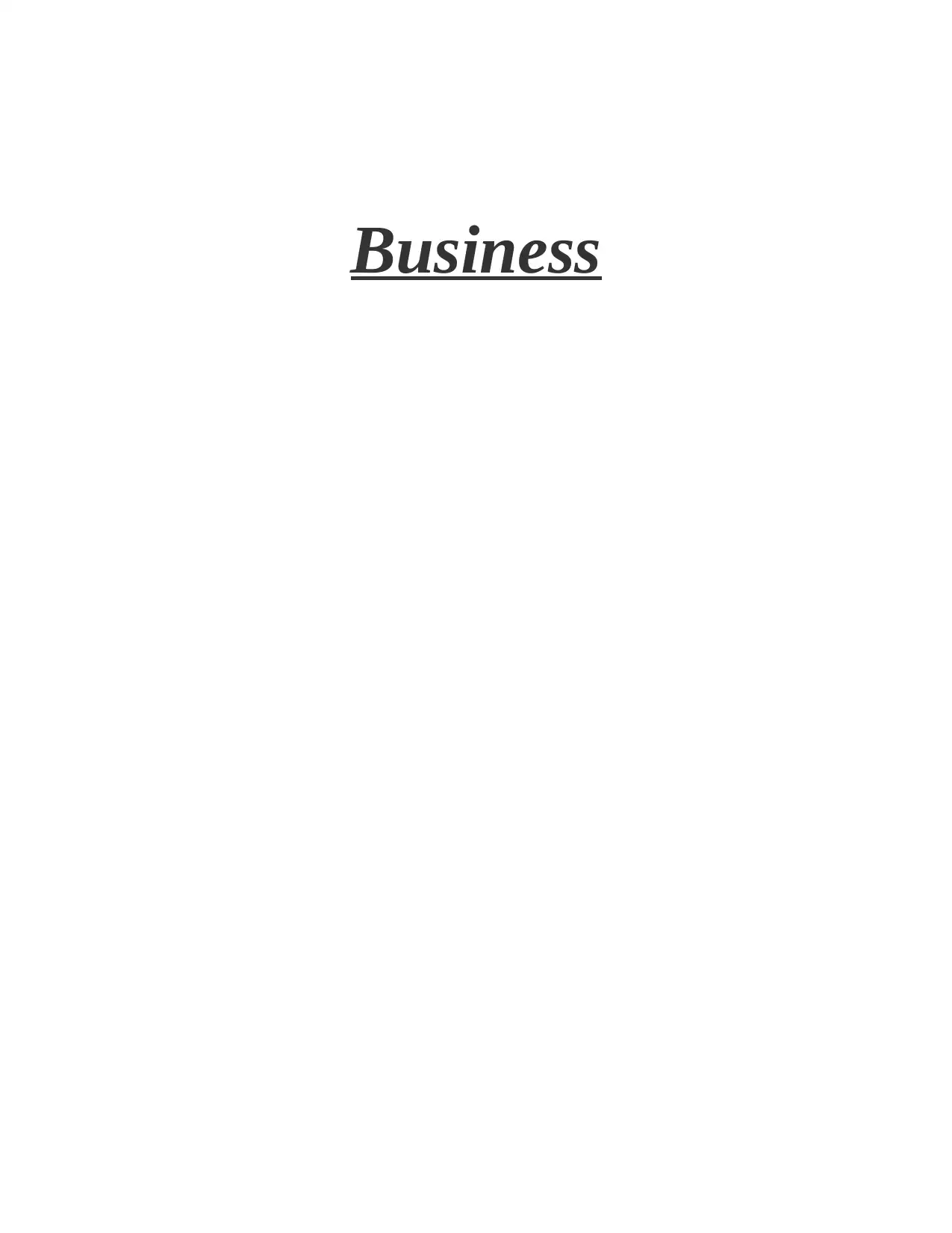
Business
Paraphrase This Document
Need a fresh take? Get an instant paraphrase of this document with our AI Paraphraser
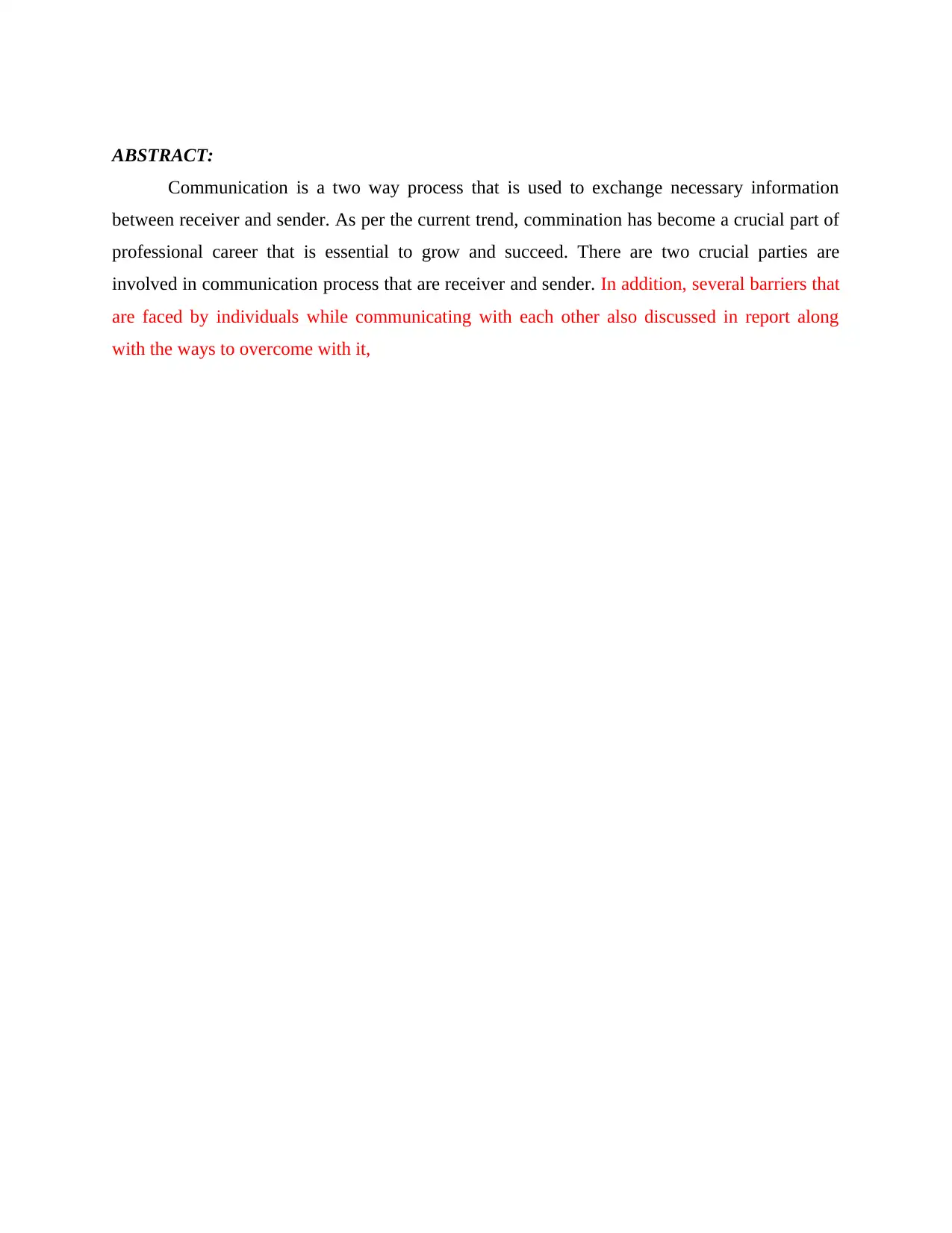
ABSTRACT:
Communication is a two way process that is used to exchange necessary information
between receiver and sender. As per the current trend, commination has become a crucial part of
professional career that is essential to grow and succeed. There are two crucial parties are
involved in communication process that are receiver and sender. In addition, several barriers that
are faced by individuals while communicating with each other also discussed in report along
with the ways to overcome with it,
Communication is a two way process that is used to exchange necessary information
between receiver and sender. As per the current trend, commination has become a crucial part of
professional career that is essential to grow and succeed. There are two crucial parties are
involved in communication process that are receiver and sender. In addition, several barriers that
are faced by individuals while communicating with each other also discussed in report along
with the ways to overcome with it,
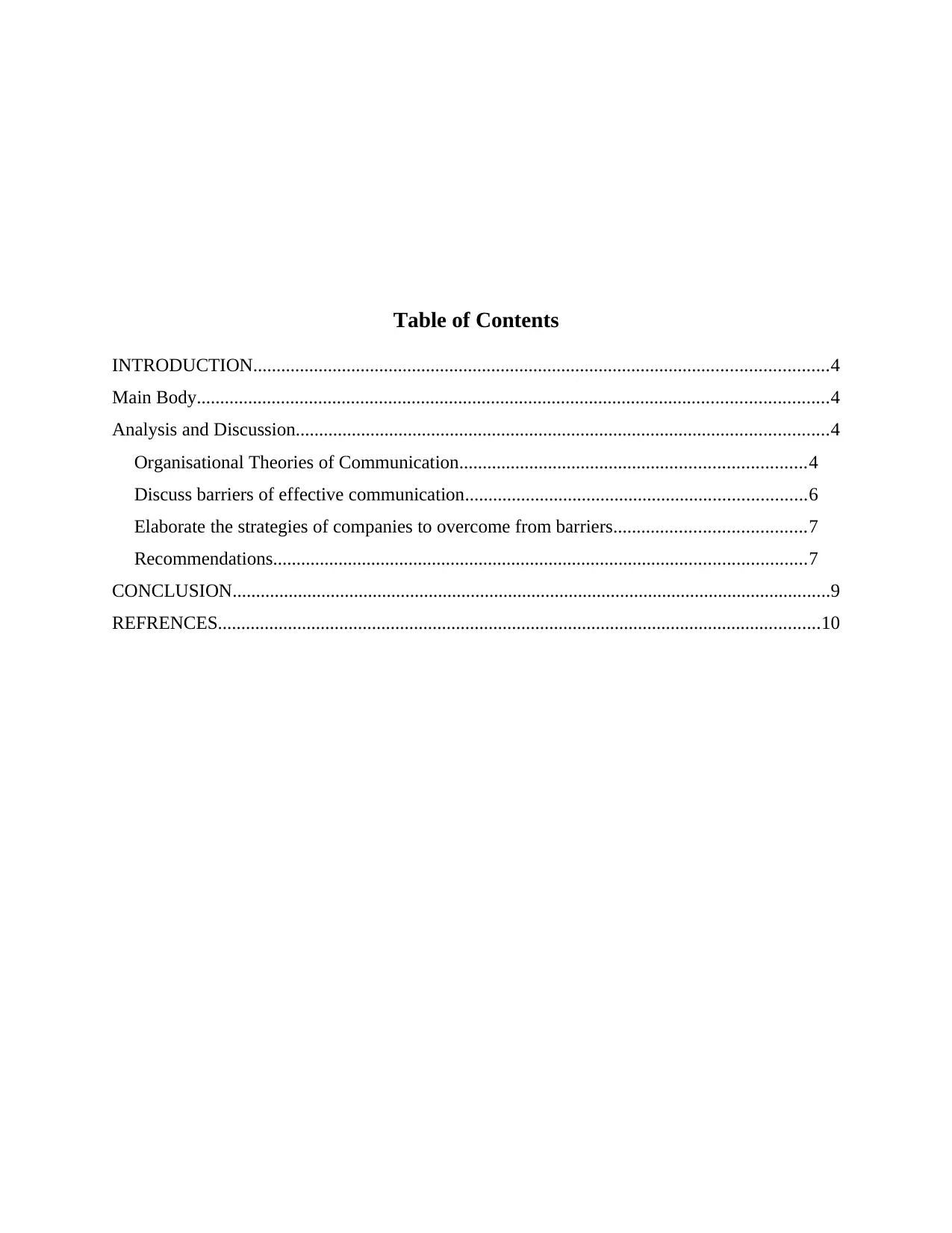
Table of Contents
INTRODUCTION...........................................................................................................................4
Main Body.......................................................................................................................................4
Analysis and Discussion..................................................................................................................4
Organisational Theories of Communication..........................................................................4
Discuss barriers of effective communication.........................................................................6
Elaborate the strategies of companies to overcome from barriers.........................................7
Recommendations..................................................................................................................7
CONCLUSION................................................................................................................................9
REFRENCES.................................................................................................................................10
INTRODUCTION...........................................................................................................................4
Main Body.......................................................................................................................................4
Analysis and Discussion..................................................................................................................4
Organisational Theories of Communication..........................................................................4
Discuss barriers of effective communication.........................................................................6
Elaborate the strategies of companies to overcome from barriers.........................................7
Recommendations..................................................................................................................7
CONCLUSION................................................................................................................................9
REFRENCES.................................................................................................................................10
⊘ This is a preview!⊘
Do you want full access?
Subscribe today to unlock all pages.

Trusted by 1+ million students worldwide
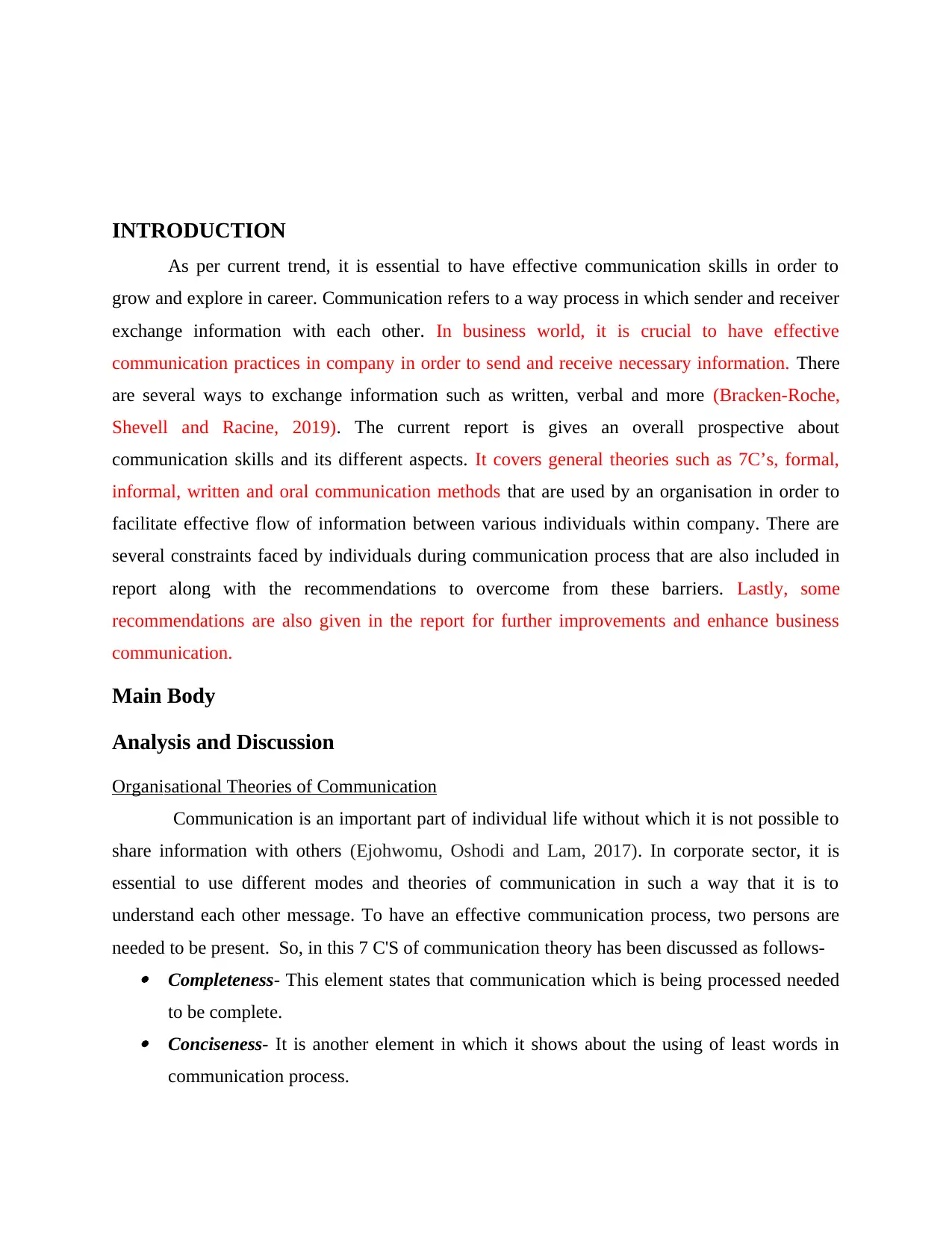
INTRODUCTION
As per current trend, it is essential to have effective communication skills in order to
grow and explore in career. Communication refers to a way process in which sender and receiver
exchange information with each other. In business world, it is crucial to have effective
communication practices in company in order to send and receive necessary information. There
are several ways to exchange information such as written, verbal and more (Bracken-Roche,
Shevell and Racine, 2019). The current report is gives an overall prospective about
communication skills and its different aspects. It covers general theories such as 7C’s, formal,
informal, written and oral communication methods that are used by an organisation in order to
facilitate effective flow of information between various individuals within company. There are
several constraints faced by individuals during communication process that are also included in
report along with the recommendations to overcome from these barriers. Lastly, some
recommendations are also given in the report for further improvements and enhance business
communication.
Main Body
Analysis and Discussion
Organisational Theories of Communication
Communication is an important part of individual life without which it is not possible to
share information with others (Ejohwomu, Oshodi and Lam, 2017). In corporate sector, it is
essential to use different modes and theories of communication in such a way that it is to
understand each other message. To have an effective communication process, two persons are
needed to be present. So, in this 7 C'S of communication theory has been discussed as follows- Completeness- This element states that communication which is being processed needed
to be complete. Conciseness- It is another element in which it shows about the using of least words in
communication process.
As per current trend, it is essential to have effective communication skills in order to
grow and explore in career. Communication refers to a way process in which sender and receiver
exchange information with each other. In business world, it is crucial to have effective
communication practices in company in order to send and receive necessary information. There
are several ways to exchange information such as written, verbal and more (Bracken-Roche,
Shevell and Racine, 2019). The current report is gives an overall prospective about
communication skills and its different aspects. It covers general theories such as 7C’s, formal,
informal, written and oral communication methods that are used by an organisation in order to
facilitate effective flow of information between various individuals within company. There are
several constraints faced by individuals during communication process that are also included in
report along with the recommendations to overcome from these barriers. Lastly, some
recommendations are also given in the report for further improvements and enhance business
communication.
Main Body
Analysis and Discussion
Organisational Theories of Communication
Communication is an important part of individual life without which it is not possible to
share information with others (Ejohwomu, Oshodi and Lam, 2017). In corporate sector, it is
essential to use different modes and theories of communication in such a way that it is to
understand each other message. To have an effective communication process, two persons are
needed to be present. So, in this 7 C'S of communication theory has been discussed as follows- Completeness- This element states that communication which is being processed needed
to be complete. Conciseness- It is another element in which it shows about the using of least words in
communication process.
Paraphrase This Document
Need a fresh take? Get an instant paraphrase of this document with our AI Paraphraser
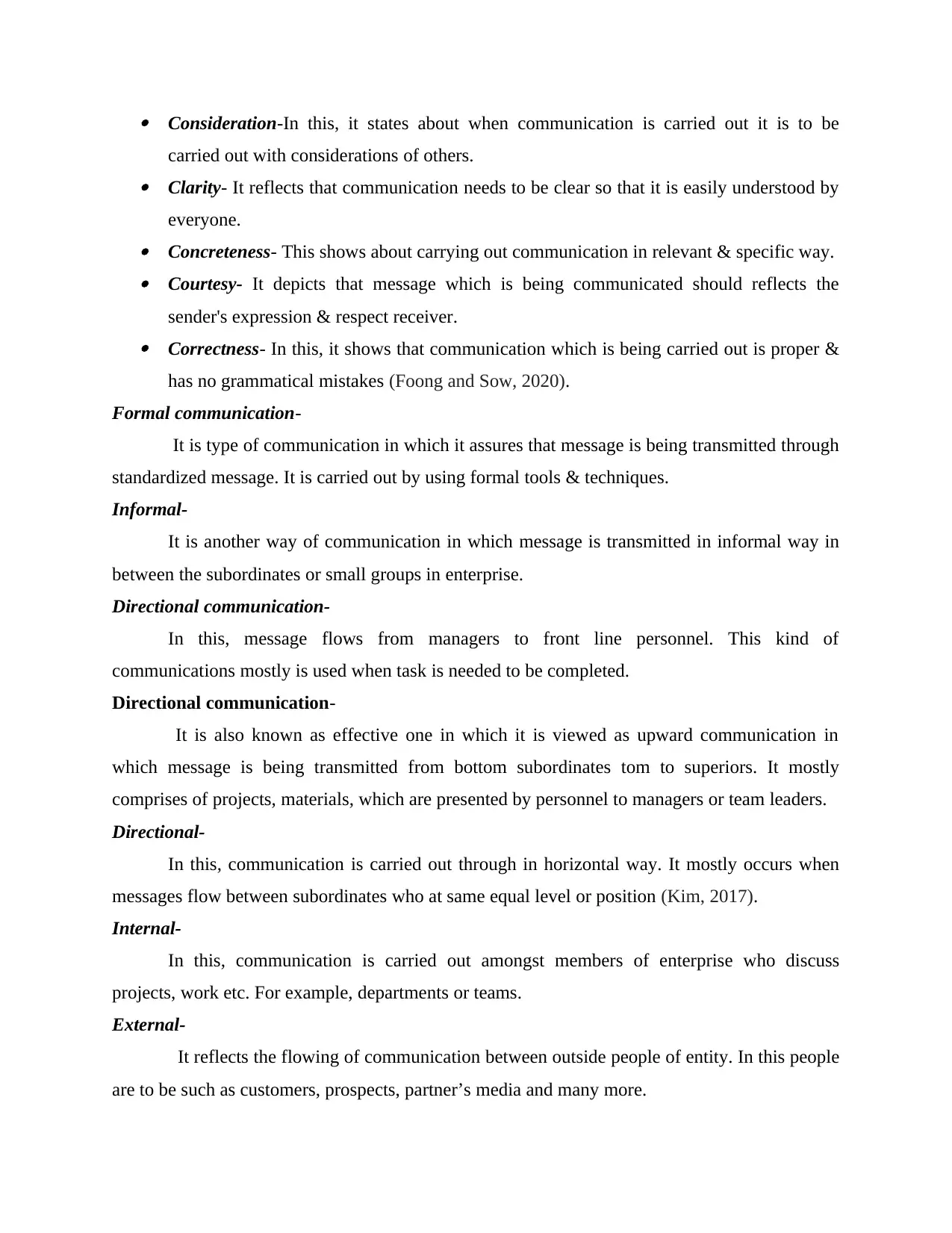
Consideration-In this, it states about when communication is carried out it is to be
carried out with considerations of others. Clarity- It reflects that communication needs to be clear so that it is easily understood by
everyone. Concreteness- This shows about carrying out communication in relevant & specific way. Courtesy- It depicts that message which is being communicated should reflects the
sender's expression & respect receiver. Correctness- In this, it shows that communication which is being carried out is proper &
has no grammatical mistakes (Foong and Sow, 2020).
Formal communication-
It is type of communication in which it assures that message is being transmitted through
standardized message. It is carried out by using formal tools & techniques.
Informal-
It is another way of communication in which message is transmitted in informal way in
between the subordinates or small groups in enterprise.
Directional communication-
In this, message flows from managers to front line personnel. This kind of
communications mostly is used when task is needed to be completed.
Directional communication-
It is also known as effective one in which it is viewed as upward communication in
which message is being transmitted from bottom subordinates tom to superiors. It mostly
comprises of projects, materials, which are presented by personnel to managers or team leaders.
Directional-
In this, communication is carried out through in horizontal way. It mostly occurs when
messages flow between subordinates who at same equal level or position (Kim, 2017).
Internal-
In this, communication is carried out amongst members of enterprise who discuss
projects, work etc. For example, departments or teams.
External-
It reflects the flowing of communication between outside people of entity. In this people
are to be such as customers, prospects, partner’s media and many more.
carried out with considerations of others. Clarity- It reflects that communication needs to be clear so that it is easily understood by
everyone. Concreteness- This shows about carrying out communication in relevant & specific way. Courtesy- It depicts that message which is being communicated should reflects the
sender's expression & respect receiver. Correctness- In this, it shows that communication which is being carried out is proper &
has no grammatical mistakes (Foong and Sow, 2020).
Formal communication-
It is type of communication in which it assures that message is being transmitted through
standardized message. It is carried out by using formal tools & techniques.
Informal-
It is another way of communication in which message is transmitted in informal way in
between the subordinates or small groups in enterprise.
Directional communication-
In this, message flows from managers to front line personnel. This kind of
communications mostly is used when task is needed to be completed.
Directional communication-
It is also known as effective one in which it is viewed as upward communication in
which message is being transmitted from bottom subordinates tom to superiors. It mostly
comprises of projects, materials, which are presented by personnel to managers or team leaders.
Directional-
In this, communication is carried out through in horizontal way. It mostly occurs when
messages flow between subordinates who at same equal level or position (Kim, 2017).
Internal-
In this, communication is carried out amongst members of enterprise who discuss
projects, work etc. For example, departments or teams.
External-
It reflects the flowing of communication between outside people of entity. In this people
are to be such as customers, prospects, partner’s media and many more.
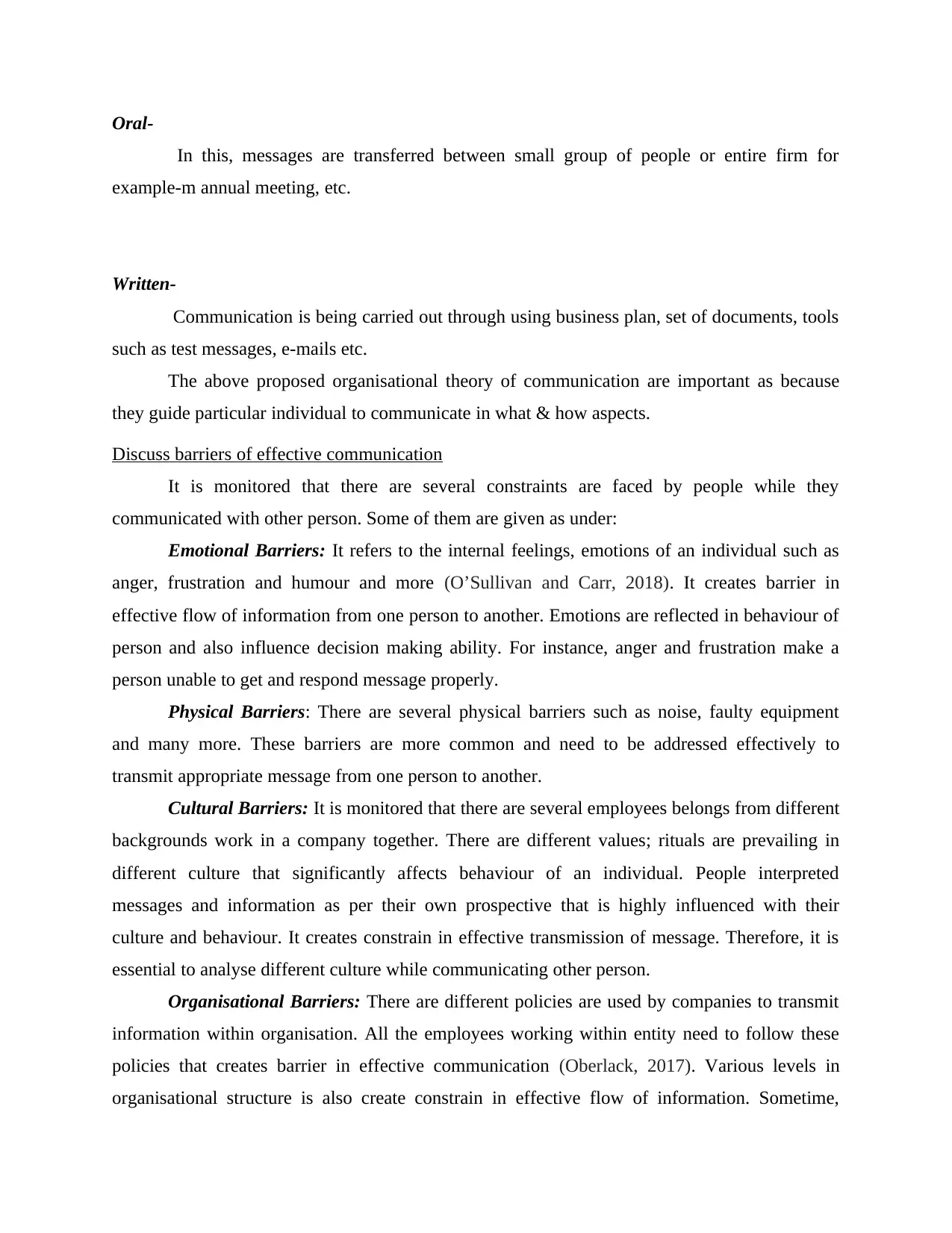
Oral-
In this, messages are transferred between small group of people or entire firm for
example-m annual meeting, etc.
Written-
Communication is being carried out through using business plan, set of documents, tools
such as test messages, e-mails etc.
The above proposed organisational theory of communication are important as because
they guide particular individual to communicate in what & how aspects.
Discuss barriers of effective communication
It is monitored that there are several constraints are faced by people while they
communicated with other person. Some of them are given as under:
Emotional Barriers: It refers to the internal feelings, emotions of an individual such as
anger, frustration and humour and more (O’Sullivan and Carr, 2018). It creates barrier in
effective flow of information from one person to another. Emotions are reflected in behaviour of
person and also influence decision making ability. For instance, anger and frustration make a
person unable to get and respond message properly.
Physical Barriers: There are several physical barriers such as noise, faulty equipment
and many more. These barriers are more common and need to be addressed effectively to
transmit appropriate message from one person to another.
Cultural Barriers: It is monitored that there are several employees belongs from different
backgrounds work in a company together. There are different values; rituals are prevailing in
different culture that significantly affects behaviour of an individual. People interpreted
messages and information as per their own prospective that is highly influenced with their
culture and behaviour. It creates constrain in effective transmission of message. Therefore, it is
essential to analyse different culture while communicating other person.
Organisational Barriers: There are different policies are used by companies to transmit
information within organisation. All the employees working within entity need to follow these
policies that creates barrier in effective communication (Oberlack, 2017). Various levels in
organisational structure is also create constrain in effective flow of information. Sometime,
In this, messages are transferred between small group of people or entire firm for
example-m annual meeting, etc.
Written-
Communication is being carried out through using business plan, set of documents, tools
such as test messages, e-mails etc.
The above proposed organisational theory of communication are important as because
they guide particular individual to communicate in what & how aspects.
Discuss barriers of effective communication
It is monitored that there are several constraints are faced by people while they
communicated with other person. Some of them are given as under:
Emotional Barriers: It refers to the internal feelings, emotions of an individual such as
anger, frustration and humour and more (O’Sullivan and Carr, 2018). It creates barrier in
effective flow of information from one person to another. Emotions are reflected in behaviour of
person and also influence decision making ability. For instance, anger and frustration make a
person unable to get and respond message properly.
Physical Barriers: There are several physical barriers such as noise, faulty equipment
and many more. These barriers are more common and need to be addressed effectively to
transmit appropriate message from one person to another.
Cultural Barriers: It is monitored that there are several employees belongs from different
backgrounds work in a company together. There are different values; rituals are prevailing in
different culture that significantly affects behaviour of an individual. People interpreted
messages and information as per their own prospective that is highly influenced with their
culture and behaviour. It creates constrain in effective transmission of message. Therefore, it is
essential to analyse different culture while communicating other person.
Organisational Barriers: There are different policies are used by companies to transmit
information within organisation. All the employees working within entity need to follow these
policies that creates barrier in effective communication (Oberlack, 2017). Various levels in
organisational structure is also create constrain in effective flow of information. Sometime,
⊘ This is a preview!⊘
Do you want full access?
Subscribe today to unlock all pages.

Trusted by 1+ million students worldwide
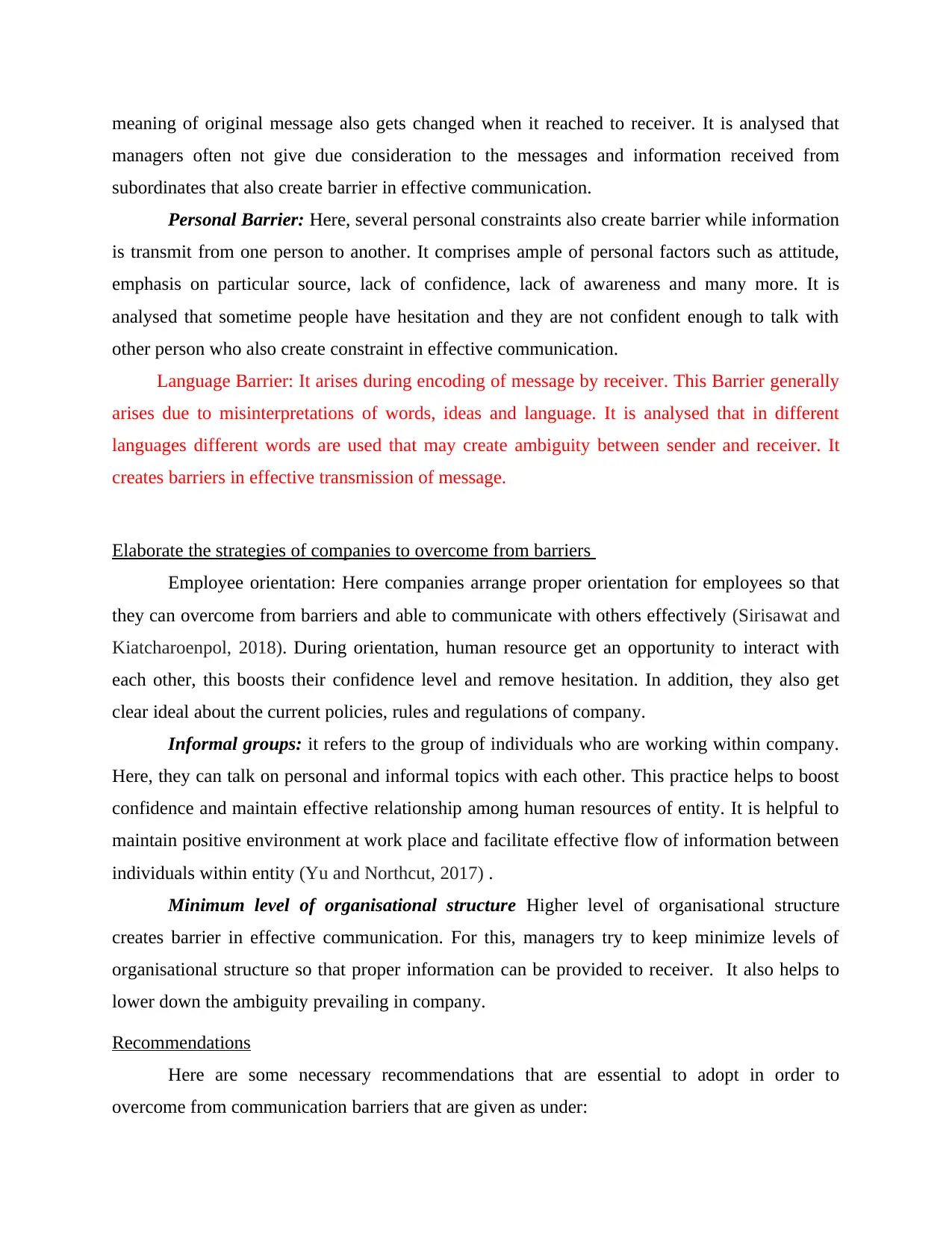
meaning of original message also gets changed when it reached to receiver. It is analysed that
managers often not give due consideration to the messages and information received from
subordinates that also create barrier in effective communication.
Personal Barrier: Here, several personal constraints also create barrier while information
is transmit from one person to another. It comprises ample of personal factors such as attitude,
emphasis on particular source, lack of confidence, lack of awareness and many more. It is
analysed that sometime people have hesitation and they are not confident enough to talk with
other person who also create constraint in effective communication.
Language Barrier: It arises during encoding of message by receiver. This Barrier generally
arises due to misinterpretations of words, ideas and language. It is analysed that in different
languages different words are used that may create ambiguity between sender and receiver. It
creates barriers in effective transmission of message.
Elaborate the strategies of companies to overcome from barriers
Employee orientation: Here companies arrange proper orientation for employees so that
they can overcome from barriers and able to communicate with others effectively (Sirisawat and
Kiatcharoenpol, 2018). During orientation, human resource get an opportunity to interact with
each other, this boosts their confidence level and remove hesitation. In addition, they also get
clear ideal about the current policies, rules and regulations of company.
Informal groups: it refers to the group of individuals who are working within company.
Here, they can talk on personal and informal topics with each other. This practice helps to boost
confidence and maintain effective relationship among human resources of entity. It is helpful to
maintain positive environment at work place and facilitate effective flow of information between
individuals within entity (Yu and Northcut, 2017) .
Minimum level of organisational structure Higher level of organisational structure
creates barrier in effective communication. For this, managers try to keep minimize levels of
organisational structure so that proper information can be provided to receiver. It also helps to
lower down the ambiguity prevailing in company.
Recommendations
Here are some necessary recommendations that are essential to adopt in order to
overcome from communication barriers that are given as under:
managers often not give due consideration to the messages and information received from
subordinates that also create barrier in effective communication.
Personal Barrier: Here, several personal constraints also create barrier while information
is transmit from one person to another. It comprises ample of personal factors such as attitude,
emphasis on particular source, lack of confidence, lack of awareness and many more. It is
analysed that sometime people have hesitation and they are not confident enough to talk with
other person who also create constraint in effective communication.
Language Barrier: It arises during encoding of message by receiver. This Barrier generally
arises due to misinterpretations of words, ideas and language. It is analysed that in different
languages different words are used that may create ambiguity between sender and receiver. It
creates barriers in effective transmission of message.
Elaborate the strategies of companies to overcome from barriers
Employee orientation: Here companies arrange proper orientation for employees so that
they can overcome from barriers and able to communicate with others effectively (Sirisawat and
Kiatcharoenpol, 2018). During orientation, human resource get an opportunity to interact with
each other, this boosts their confidence level and remove hesitation. In addition, they also get
clear ideal about the current policies, rules and regulations of company.
Informal groups: it refers to the group of individuals who are working within company.
Here, they can talk on personal and informal topics with each other. This practice helps to boost
confidence and maintain effective relationship among human resources of entity. It is helpful to
maintain positive environment at work place and facilitate effective flow of information between
individuals within entity (Yu and Northcut, 2017) .
Minimum level of organisational structure Higher level of organisational structure
creates barrier in effective communication. For this, managers try to keep minimize levels of
organisational structure so that proper information can be provided to receiver. It also helps to
lower down the ambiguity prevailing in company.
Recommendations
Here are some necessary recommendations that are essential to adopt in order to
overcome from communication barriers that are given as under:
Paraphrase This Document
Need a fresh take? Get an instant paraphrase of this document with our AI Paraphraser
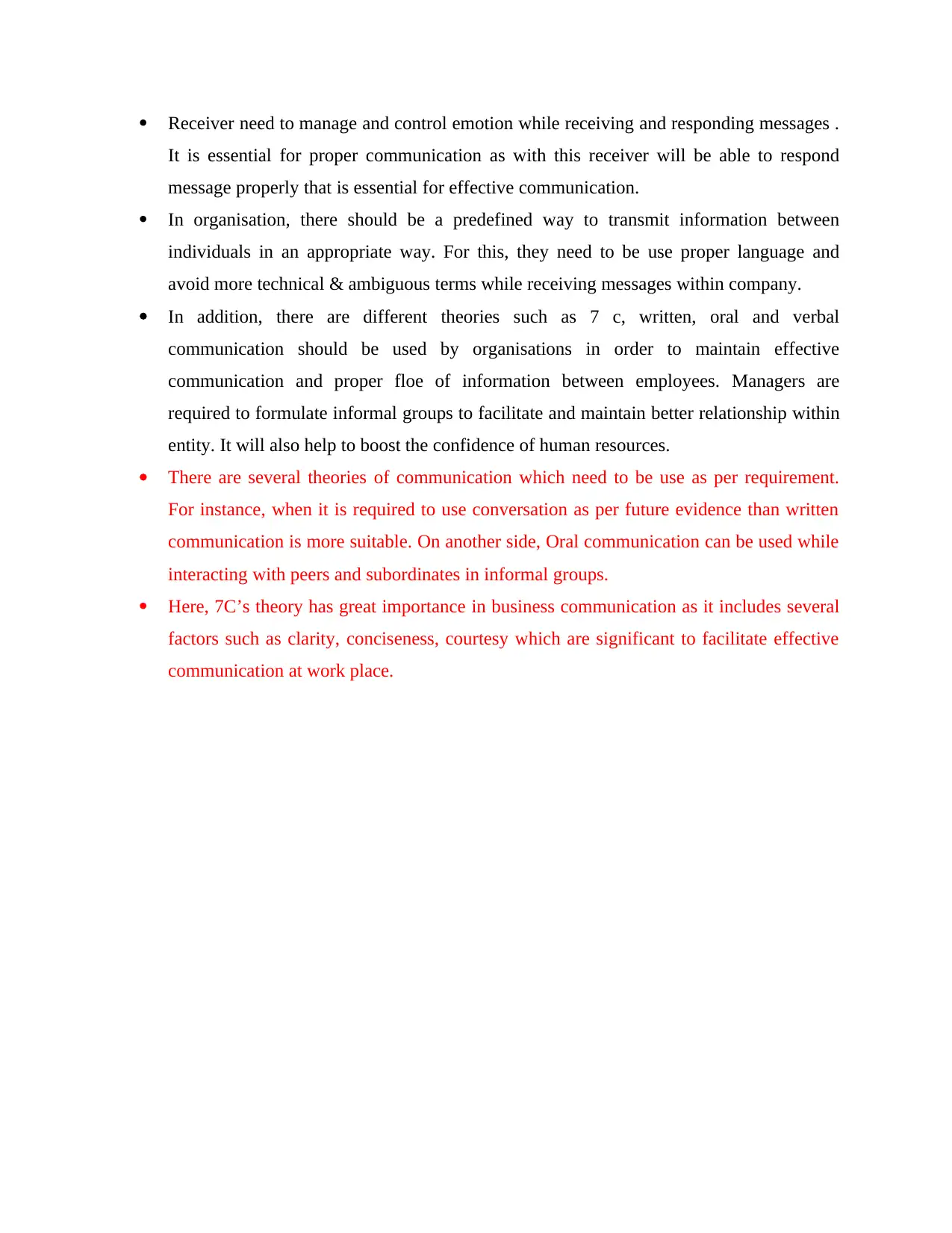
Receiver need to manage and control emotion while receiving and responding messages .
It is essential for proper communication as with this receiver will be able to respond
message properly that is essential for effective communication.
In organisation, there should be a predefined way to transmit information between
individuals in an appropriate way. For this, they need to be use proper language and
avoid more technical & ambiguous terms while receiving messages within company.
In addition, there are different theories such as 7 c, written, oral and verbal
communication should be used by organisations in order to maintain effective
communication and proper floe of information between employees. Managers are
required to formulate informal groups to facilitate and maintain better relationship within
entity. It will also help to boost the confidence of human resources.
There are several theories of communication which need to be use as per requirement.
For instance, when it is required to use conversation as per future evidence than written
communication is more suitable. On another side, Oral communication can be used while
interacting with peers and subordinates in informal groups.
Here, 7C’s theory has great importance in business communication as it includes several
factors such as clarity, conciseness, courtesy which are significant to facilitate effective
communication at work place.
It is essential for proper communication as with this receiver will be able to respond
message properly that is essential for effective communication.
In organisation, there should be a predefined way to transmit information between
individuals in an appropriate way. For this, they need to be use proper language and
avoid more technical & ambiguous terms while receiving messages within company.
In addition, there are different theories such as 7 c, written, oral and verbal
communication should be used by organisations in order to maintain effective
communication and proper floe of information between employees. Managers are
required to formulate informal groups to facilitate and maintain better relationship within
entity. It will also help to boost the confidence of human resources.
There are several theories of communication which need to be use as per requirement.
For instance, when it is required to use conversation as per future evidence than written
communication is more suitable. On another side, Oral communication can be used while
interacting with peers and subordinates in informal groups.
Here, 7C’s theory has great importance in business communication as it includes several
factors such as clarity, conciseness, courtesy which are significant to facilitate effective
communication at work place.
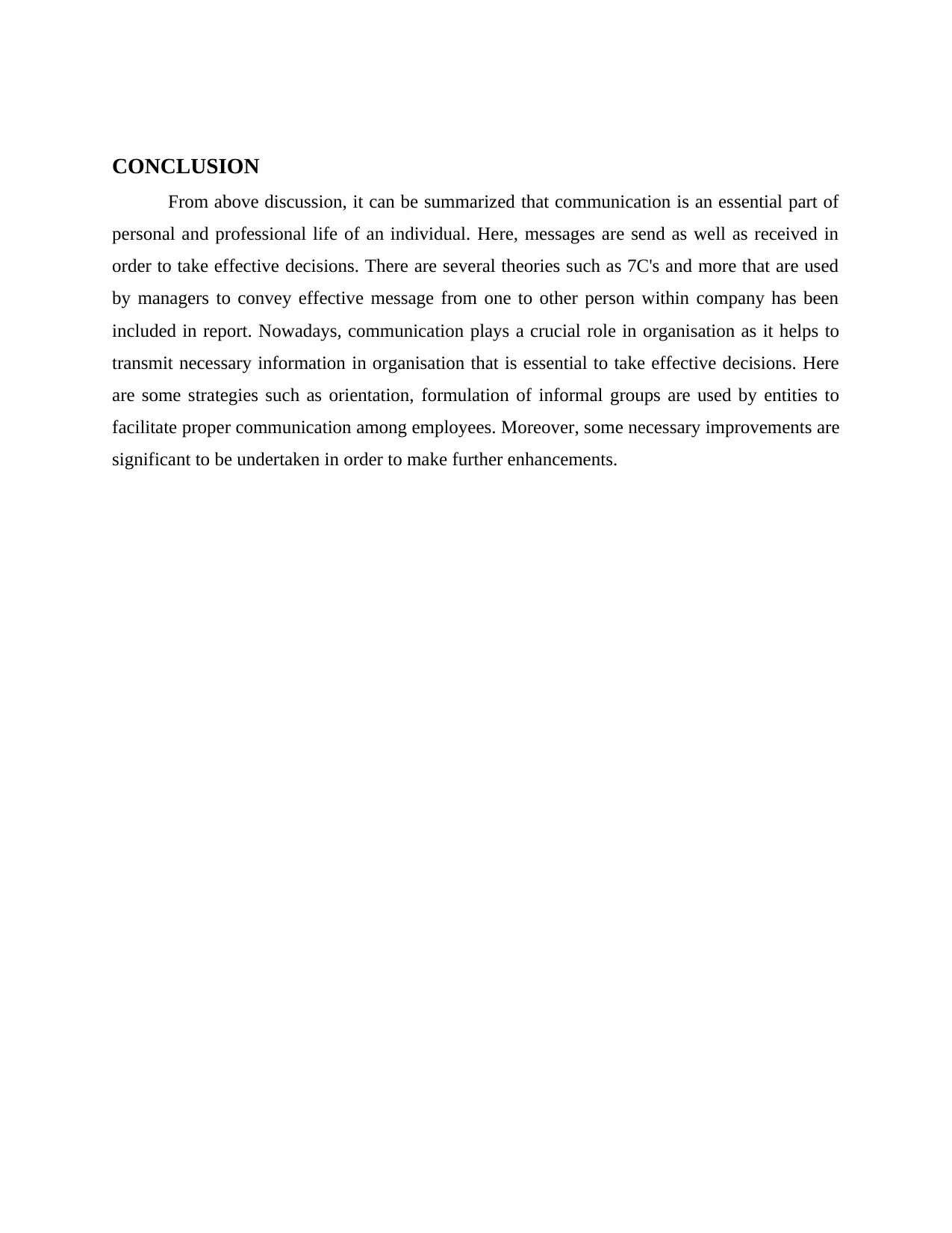
CONCLUSION
From above discussion, it can be summarized that communication is an essential part of
personal and professional life of an individual. Here, messages are send as well as received in
order to take effective decisions. There are several theories such as 7C's and more that are used
by managers to convey effective message from one to other person within company has been
included in report. Nowadays, communication plays a crucial role in organisation as it helps to
transmit necessary information in organisation that is essential to take effective decisions. Here
are some strategies such as orientation, formulation of informal groups are used by entities to
facilitate proper communication among employees. Moreover, some necessary improvements are
significant to be undertaken in order to make further enhancements.
From above discussion, it can be summarized that communication is an essential part of
personal and professional life of an individual. Here, messages are send as well as received in
order to take effective decisions. There are several theories such as 7C's and more that are used
by managers to convey effective message from one to other person within company has been
included in report. Nowadays, communication plays a crucial role in organisation as it helps to
transmit necessary information in organisation that is essential to take effective decisions. Here
are some strategies such as orientation, formulation of informal groups are used by entities to
facilitate proper communication among employees. Moreover, some necessary improvements are
significant to be undertaken in order to make further enhancements.
⊘ This is a preview!⊘
Do you want full access?
Subscribe today to unlock all pages.

Trusted by 1+ million students worldwide
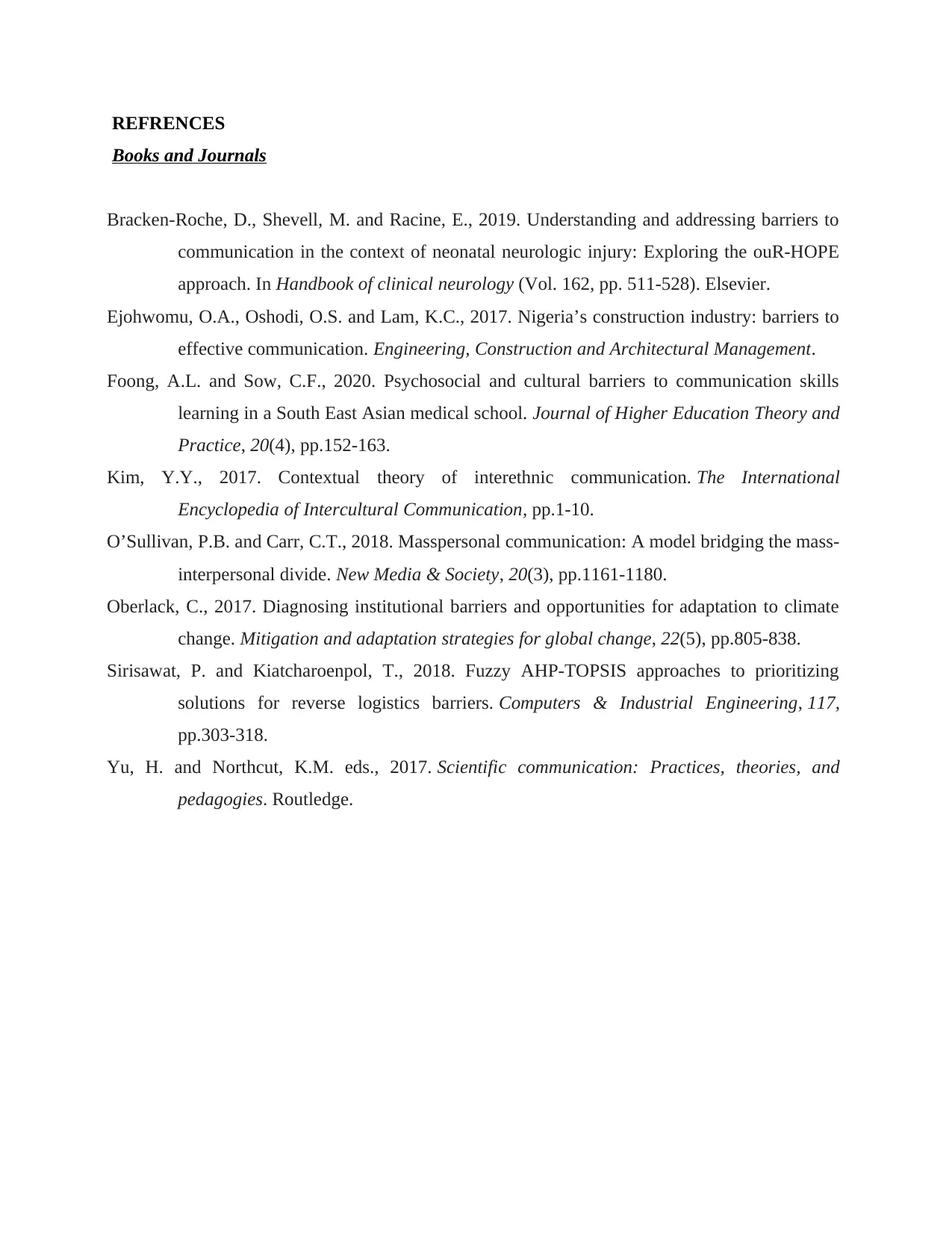
REFRENCES
Books and Journals
Bracken-Roche, D., Shevell, M. and Racine, E., 2019. Understanding and addressing barriers to
communication in the context of neonatal neurologic injury: Exploring the ouR-HOPE
approach. In Handbook of clinical neurology (Vol. 162, pp. 511-528). Elsevier.
Ejohwomu, O.A., Oshodi, O.S. and Lam, K.C., 2017. Nigeria’s construction industry: barriers to
effective communication. Engineering, Construction and Architectural Management.
Foong, A.L. and Sow, C.F., 2020. Psychosocial and cultural barriers to communication skills
learning in a South East Asian medical school. Journal of Higher Education Theory and
Practice, 20(4), pp.152-163.
Kim, Y.Y., 2017. Contextual theory of interethnic communication. The International
Encyclopedia of Intercultural Communication, pp.1-10.
O’Sullivan, P.B. and Carr, C.T., 2018. Masspersonal communication: A model bridging the mass-
interpersonal divide. New Media & Society, 20(3), pp.1161-1180.
Oberlack, C., 2017. Diagnosing institutional barriers and opportunities for adaptation to climate
change. Mitigation and adaptation strategies for global change, 22(5), pp.805-838.
Sirisawat, P. and Kiatcharoenpol, T., 2018. Fuzzy AHP-TOPSIS approaches to prioritizing
solutions for reverse logistics barriers. Computers & Industrial Engineering, 117,
pp.303-318.
Yu, H. and Northcut, K.M. eds., 2017. Scientific communication: Practices, theories, and
pedagogies. Routledge.
Books and Journals
Bracken-Roche, D., Shevell, M. and Racine, E., 2019. Understanding and addressing barriers to
communication in the context of neonatal neurologic injury: Exploring the ouR-HOPE
approach. In Handbook of clinical neurology (Vol. 162, pp. 511-528). Elsevier.
Ejohwomu, O.A., Oshodi, O.S. and Lam, K.C., 2017. Nigeria’s construction industry: barriers to
effective communication. Engineering, Construction and Architectural Management.
Foong, A.L. and Sow, C.F., 2020. Psychosocial and cultural barriers to communication skills
learning in a South East Asian medical school. Journal of Higher Education Theory and
Practice, 20(4), pp.152-163.
Kim, Y.Y., 2017. Contextual theory of interethnic communication. The International
Encyclopedia of Intercultural Communication, pp.1-10.
O’Sullivan, P.B. and Carr, C.T., 2018. Masspersonal communication: A model bridging the mass-
interpersonal divide. New Media & Society, 20(3), pp.1161-1180.
Oberlack, C., 2017. Diagnosing institutional barriers and opportunities for adaptation to climate
change. Mitigation and adaptation strategies for global change, 22(5), pp.805-838.
Sirisawat, P. and Kiatcharoenpol, T., 2018. Fuzzy AHP-TOPSIS approaches to prioritizing
solutions for reverse logistics barriers. Computers & Industrial Engineering, 117,
pp.303-318.
Yu, H. and Northcut, K.M. eds., 2017. Scientific communication: Practices, theories, and
pedagogies. Routledge.
1 out of 10
Related Documents
Your All-in-One AI-Powered Toolkit for Academic Success.
+13062052269
info@desklib.com
Available 24*7 on WhatsApp / Email
![[object Object]](/_next/static/media/star-bottom.7253800d.svg)
Unlock your academic potential
Copyright © 2020–2025 A2Z Services. All Rights Reserved. Developed and managed by ZUCOL.





